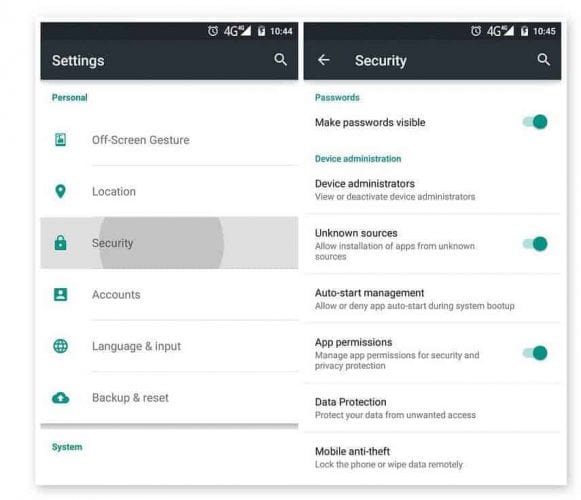- SecTools.Org: List of 75 security tools based on a 2003 vote by hackers.
- Hakin9: E-magazine offering in-depth looks at both attack and defense techniques and concentrates on difficult technical issues.
- Exploit DB: An archive of exploits and vulnerable software by Offensive Security. The site collects exploits from submissions and mailing lists and concentrates them in a single database.
- Hacked Gadgets: A resource for DIY project documentation as well as general gadget and technology news.
- The Hacker News: The Hacker News — most trusted and widely-acknowledged online cyber security news magazine with in-depth technical coverage for cybersecurity.
- Phrack Magazine: Digital hacking magazine.
- KitPloit: Leading source of Security Tools, Hacking Tools, CyberSecurity and Network Security.
- Packet Storm: Information Security Services, News, Files, Tools, Exploits, Advisories and Whitepapers.
- Metasploit: Find security issues, verify vulnerability mitigations & manage security assessments with Metasploit. Get the worlds best penetration testing software now.
- HackRead: HackRead is a News Platform that centers on InfoSec, Cyber Crime, Privacy, Surveillance, and Hacking News with full-scale reviews on Social Media Platforms.
martes, 30 de junio de 2020
10 Hacking Websites & forums - Underground hacker sites
domingo, 28 de junio de 2020
re: please send me the Facebook traffic offer
sucreactivo.insurgente
here it is, social website traffic:
http://www.mgdots.co/detail.php?id=113
Full details attached
Regards
Jacquline Hammill
Unsubscribe option is available on the footer of our website
sábado, 13 de junio de 2020
re: How to remove a site from top 10 for important keywords
http://www.blackhat.to
viernes, 12 de junio de 2020
How To Hack Any Game On Your Android Smartphone

How To Hack Any Game On Android 2018
Steps To Hack Any Game On Android
Using Game Guardian
Read more
10 Best Wifi Hacking Android Apps To Hack Others Wifi (Without Root)
Top 10 Best wifi hacking apps to hack wifi^s.
Today, a smartphone without internet is like a decade ago featured phone which is mainly used to dial and receive the call. No one would even want such a phone today. The Internet is now a necessity for every mobile user. They can't live without the internet and unfortunately; if the Internet is not working due to some signal issues; they get frustrated and sometimes depressed too.
Generally, we need to pay for the Internet subscription package to run mobile data on our smartphone. But what to do if I don't want to spend money on the Internet? The solution is to connect your mobile with WiFi. You can access the internet from there. Easy, right? NO, it's not easy until you know the password of WiFi. But what if you don't know.
Two ways possible in this situation
- Either you ask for the password to the owner; he will provide you to use his internet through Wi-Fi
- You have to hack the Wi-Fi password of other's network and use the internet as an unauthorized person.
First is not reliable when you don't know the person so, you only have a second option. Today, I am going to share a few apps that help you steal the password and allow you to use the internet from others' account.
1. WiFi WPS WPA Tester
This is the foremost tool to hack the WiFi password without knowing even the root. This is a preferred choice of numerous smartphone users to decipher the pin and get access to the Wi-Fi. As time passes, a tool is upgraded and now even hack the WiFi networks while it was used to check if an access point is highly vulnerable to the rancorous attacks or not.
If you are using Lollipop or above version on your android mobile phone; you don't even need to root your device to crack a WiFi network.
Android AppPros
- Easy to use
- Free
- Decrypt the password in no time.
- Implementation of several algos like Zhao, Arris, Dlink and more.
Cons
- Need root access if you are using the version below Lollipop.
2. WPS Connect
Routers which has enabled a WPS protocol can be hacked with this app. The important thing is that almost all routers found in public places and homes fall under this category. In short, you will have what you want. Moreover, you can focus on your router & examine that it's vulnerable to any malicious attack or not. It helps you hack the WiFi password without root and also strengthen your WiFi network.
Once you identify the vulnerable (accessible) network, you can quickly get the password and start using the internet without any hassle. It uses algorithms like easyboxPIN and Zhao. Although, this app is not compatible with various Android phones as it is tested on Android devices like the Galaxy series, Nexus and more.
Android AppPros
- It's free and easy to use
- Powerful algorithms (Zhao & easyboxPin) to crack the password
- Supports pinning of Wi-Fi routers
Cons
- Incompatible with few android devices
- Couldn't identify the network automatically.
3. WiFi WPS WPA Tester Premium
This is an excellent app to decrypt the WiFi network password on your android phone. This works fine on rooted & non-rooted android phones. If you can root the Android device; you can have a better chance to hack into. Today, security is the primary concern and so, many people use the highly secured wireless router, I think. For such networks, this app will not work as it should be. But, still it can work for numerous times with the help of WPS; not all the time. Every time, you have to try your luck to get access to other's WiFi network. This WPS WPA tester is a premium apk.
Android AppPros
- Works for both rooted and non-rooted android devices
- Find the nearby network and connect your mobile with it.
Cons
- It's a premium apk.
- You have to try your luck to get access to the nearby network.
- Not good to connect with highly secured wireless routers.
4. AndroDumpper Wifi (WPS Connect) – Discontinued
If you want to connect to a router which is WPS enabled; download this app immediately without going down to browse for other apps. Just open the app, start its interface & find the nearby wireless networks, you want to connect with. The app will provide an excellent option to regain the password of a selected network with & without root. Once you implemented the algorithm; it will display the password in app screen & connect to the network. Isn't it easy for you?
Android AppPros
- It's Free on Google Play Store
- Easy to use and faster than some other tool.
- Works fine for rooted & non-rooted devices
- A dedicated blog is available for the tool (Get guidance anytime)
- Supports for giant company routers (Vodaphone, Asus, Huawei, Dlink, etc.)
Cons
- Rooting is required if you are using a version below android 5.0
- Works only for WPS enabled routers.
5. Wi-fi Password Hacker Prank
Wifi Password hacker prank is a free app for the android users and can help you to connect your android phone to wifi networks available nearby. This free app simulates a process of hacking the wireless network with your smartphone. With this app, you can hack all wifi network passwords with just one key. The Prank word itself says it's a funny app used to prank with your friends. Sometimes, girls can be impressed with this prank as well. But try this at your own risk. Look excellent and professional in front of your friends and colleagues.
Steps to Hack Wifi using the Wifi Password Hacker Prank:
- Catch up the wireless networks near to you and then select the secure network you wish to hack.
- Wait for a while & a dialogue will be opened with the wifi password.
- Bingo! Paste the password and start using others' Internet without spending single money.
- Watch your favourite show and movie in High-Definition quality without worrying about your mobile data.
6. WiFi Warden
WiFi Warden is one of the finest and free android WiFi hacking apps to get access to others WiFi with ease. With WiFi Warden, a user can Analyze the WiFi networks, connect to your WiFi using the passphrase and WPS and view saved WiFi passwords without root.
By analyzing the WiFi networks, you can see all necessary information that can be discovered on the wireless networks around including BSSID, SSID, Channel bandwidth, encryption, security, router manufacturer, distance and channel number, etc.
Android AppPros
- Find the less crowded channel to get WiFi access.
- You can root your device on all Android versions.
- Easy to use and connect with the router quickly.
- All features of this app are available for free.
Cons
- This app doesn't work on all types of router, use a passphrase instead.
- Access Point (AP) must have enabled WPS.
- Require Android version 6 (Marshmallow) or higher version is necessary to display Wi-Fi networks around you.
- Some of the features are in the testing phase. So, use it your own risk.
7. WiFi Password
'WiFi Password' is a completely free app for those who don't want to get away from the Internet even when their internet data is running out. You can connect with others' WiFi routers and use their Internet.
If you are using Android Version 5 or above; 'WiFi Password' can be the right choice for you to watch your favorite shows on YouTube in HD without even worrying about Mobile Data.
Android AppPros:
- Millions of WiFi Hotspots
- Scan and detect the WiFi security
- Connect WiFi Hotspot nearby without knowing the WiFi Password
- You can simply add a free WiFi Hotspot by sharing the passwords with others.
Cons :
- Still, there are some glitches in it but works well.
8. WiFi Kill Pro
WiFi Kill is one the best WiFi network controller application which can disable the Internet connection of others who are connected to the same network. Yes, this is true. It is a useful tool for internet users who want to improve their data speed by disabling other's internet connection and allocate all the bandwidth to your device only.
Currently, this app is only for Android users and needs root access to perform well.
Android AppPros
- You can see all connected device on the same network you are connected.
- Display the data transfer rate of all devices
- Monitor network activity
- You can cut the network connection of any connected device.
- It works well on tablets too.
Cons
- Require root access
- Require Android version 4.0.3 or up to use this app.
9. Penetrate Pro
A popular Wifi hacker app for android users, Penetrate pro is free and works well on Android devices. This app is widely used to find WEP and/or WPA keys to connect the devices with network routers without knowing the wifi password. Just install the app and search for the network; this app starts automatically displaying the WEP/WPA keys on the screen. Tap on the network you want to connect; one it gets connected; you can start watching videos on YouTube. Quite interesting, doesn't it?
Android AppPros
- Easy to search nearby free wifi networks.
- Connect the network without knowing keys
- Available for Free
Cons
- Not available on Google Play Store; need to download manually.
- Works well only for the rooted android devices
So, you have got the list of apps that help you use the internet from other's wireless network without getting caught. If you have any idea of any other Wi-Fi password hacking app; just let me know. We would love to discuss it here.
Disclaimer: VR Bonkers is not responsible for any consequences if you face while using any of the above apps. This is just a list and we are not taking any responsibility for the same. So, use them at your risk.
@EVERYTHING NT
Related posts
jueves, 11 de junio de 2020
Workshop And Presentation Slides And Materials
Related news
¡Todos Contra IBM! O Cómo La Empresa Compaq Venció (Con La Ayuda De Amigos) Al Gigante IBM En La Guerra Del PC
 |
| Figura 1: ¡Todos contra IBM! o cómo la empresa Compaq venció (con la ayuda de amigos) al gigante IBM en la guerra del PC |
 |
| Figura 2: Libro de Microhistorias: Anécdotas y curiosidades de la historia de la informática (y los hackers) en 0xWord |
Esta tarea, por supuesto, no fue nada fácil. Los tres fundadores de Compaq, Rod Canion, Jim Harris y Bill Murto, tenían claro que este proceso tenía que ser muy cuidadoso. Para evitar que IBM les acusara de plagio por copiar la BIOS, decidieron crear una ellos mismos. Para ello aplicaron ingeniería inversa a la BIOS de IBM y partiendo de esta información, crear una propia y así evitar alguna demanda (aunque de esto no se librarían como veremos más adelante). Para esta ardua tarea, crearon dos equipos, uno iría realizando la ingeniería inversa a la BIOS original tal y como hemos contado antes, y otro comenzaría desde cero a crear otra partiendo de los datos del primero.
 |
| Figura 3: Jim Harris, Bil Murto y Rod Canion, fundadores de Compaq |
Resumiendo esta parte de la historia (todo lo que rodea a la fundación de Compaq y la ingeniería inversa daría para otra Microhistoria), finalmente lo consiguieron y así nació el primer clónico IBM que además era portátil, el Compaq Portable (unos 3500$ de la época, con doble disquetera). A pesar de que invirtieron un millón de dólares en la fabricación, fue muy rentable ya que consiguieron más de 111 millones sólo el primer año de su puesta en el mercado. Misión cumplida, pero esto es sólo el comienzo de la historia de David (y algunos amigos) contra Goliat.
 |
| Figura 4: El primer ordenador compatible IBM, el Compaq Portable |
IBM como podéis imaginar, no se quedó de brazos cruzados. Intentó por todos lo medios evitar que Compaq pudiera sacar al mercado sus ordenadores clónicos, utilizando todos sus recursos legales (que eran auténticos ejércitos de abogados). Al final consiguieron que Compaq pagara varios millones de multas por infringir sus patentes, las cuales curiosamente no tenían nada que ver con la BIOS, sino con otros componentes del ordenador como, por ejemplo, la fuente de alimentación.
 |
| Figura 5: Logotipo original de Compaq |
A finales de los ochenta, Compaq ya vendía más ordenadores que IBM, algo realmente impensable unos años antes. En 1987, IBM, en un movimiento desesperado de reacción contra Compaq, sorprendió a la industria con una nueva tecnología llamada Micro Channel Architecture o el bus Micro Channel (MCA) de 16/32 bits, muy superior en funcionalidad comparada con la actual tecnología bus ISA. Además, sacaron simultáneamente un flamante nuevo ordenador el cual llevaba implementada esta nueva arquitectura: el IBM PS/2. La idea era ofrecer algo nuevo, innovador que mantuviera a los fabricantes de clónicos ocupados durante unos años y de esta forma volver a tomar la delantera en el mercado de los PCs.
El nuevo hardware era un cambio radical. Además de incluir los nuevos MCA se incluyeron otras nuevas características como el ya famoso puerto PS/2 para teclado y ratón, doble BIOS (una para la compatibilidad con los viejos PCs (Compatible BIOS, CBIOS) y otra totalmente nueva (Advanced BIOS, ABIOS). Esta nueva ABIOS incluía un modo protegido utilizado por el sistema operativo OS/2, la otra sorpresa presentada por IBM.
 |
| Figura 6: Modelos de la familia PS/2 de IBM |
OS/2 era un sistema operativo (desarrollado junto a Microsoft) que fue anunciado a la vez que el IBM PS/2, el problema es que este se puso en el mercado un poco tarde, y por lo tanto los primeros modelos venían con el clásico IBM PC DOS 3.3. A pesar de todo, la jugada parecía que iba a funcionar. La nueva arquitectura era mucho mejor que la anterior y, además, prácticamente todo el software (la gran baza que todos los fabricantes querían mantener) era compatible.
 |
| Figura 7: Aspecto del OS/2 Warp, el cual tiene un razonable parecido a Windows |
IBM protegió toda la tecnología del IBM PS/2 rozando casi lo absurdo. El número de patentes asociados a todos los componentes ya sea software o hardware era realmente inmenso. No podían dejar que volviera a pasar lo mismo que ocurrió con Compaq. Esta vez iban a crear de nuevo un imperio, pero con sus normas desde la base. De hecho, las tasas que cobraban (hasta un 5%) para que una tercera empresa pudiera utilizar su nueva tecnología eran realmente exageradas, lo que provocó que sólo un pequeño número de compañías se atrevieran a fabricar tanto hardware como software compatible con el PS/2.
 |
| Figura 8: Aspecto de una tarjeta gráfica IBM XGA-2 de 32 bis con tecnología MCA |
En 1988, sólo un año después del movimiento de IBM, las nueve principales empresas que fabricaban ordenadores clónicos IBM de la época: AST Research, Compaq Computer (liderando este consorcio), Epson, HP, NEC, Olivetti, Tandy, WYSE y Zenith Data Systems reaccionaron ante este desafío haciendo algo realmente innovador y que IBM no esperaba en absoluto: crearon un estándar nuevo "abierto" llamado EISA el cual era compatible con todo el hardware actual del IBM PC XT-Bus. Pero además ofrecía nuevas características (como el bus mastering, que permitía el acceso a 4GB de memoria) para hacerlo más rápido y eficiente, casi al nivel del MCA. Esto no lo esperaba IBM.
 |
| Figura 9: Aspecto del bus EISA |
Este cambio total de estrategia descolocó totalmente al Gigante Azul, el cual intentó por todos los medios impulsar sus IBM PS/2 así como OS/2 pero poco a poco, EISA fue ganando la batalla. EISA era más barato de implementar y además al ser abierto, cualquiera podría fabricarlo. Había comenzado la batalla final por la supremacía de la industria del PC. Pero EISA había nacido para ganar desde el primer momento.
 |
| Figura 10: Tarjeta de vídeo EISA e ISA, ELSA Winner 1000 |
Después del fracaso del MCA y los PS/2, a pesar de ser un gran ordenador y sistema operativo, IBM comenzó su declive como fabricante de ordenadores PC. Pero aún así, IBM se mantuvo a flote con las ventas del PS/2 (vendió 1.5 millones de unidades) e incluso llegó a fabricar, en 1996, ordenadores con el bus EISA integrado hasta la llegada del PCI. Pero IBM se atascó en el mercado del PC y finalmente en 2004, vendió su división de ordenadores a la empresa china Lenovo. IBM no soportó el tremendo fracaso del PS/2 y la inesperada estrategia del clan de los nueve. Compaq había ganado la batalla del PC.
Pero lo más curioso de todo esto, es que realmente la ganadora al final de todas estas batallas sin piedad ha sido IBM. Después de encarnizada lucha con Compaq, IBM se centró más en software (empresarial), servidores e incluso superordenadores, es decir, más investigación y supercomputación. Hoy día IBM es uno de los líderes en investigación relacionada con la Inteligencia Artificial (IA) y su flamante Watson, hardware y software de IA orientado a los negocios, lanzando Power9 - por ejemplo -, y está apostando fuerte por el ordenador cuántico. También es propietaria de una de las distribuciones Linux más extendidas a nivel comercial, Red Hat. IBM es posiblemente la mejor demostración implícita de cómo reinventarse cuando algo o alguien nos quita nuestro "queso", algo que ahora, lamentablemente, tenemos más que nunca tener en cuenta ante la nueva situación mundial, tal y como Chema Alonso explicó en este post.
 |
| Figura 10: El superordenador IBM Watson |
Pero IBM ha sobrevivido y sigue a la cabeza de la innovación tecnológica. De hecho, el primer ordenador cuántico comercial también ha sido fabricado por IBM. ¿Estamos ante las puertas de una nueva guerra, esta vez por el mercado del ordenador cuántico? En cierta manera, IBM ha vuelto a la delantera del "PC" (cuántico esta vez). De todas formas, a ver quién es el/la valiente que le hace ingeniería inversa a la BIOS de un ordenador cuántico, si es que tiene alguna ;). Por cierto, el documental "Silicon Cowboys" explica en detalle la historia de Compaq y su guerra con IBM. No está mal para tres emprendedores que, en principio, querían montar un restaurante de comida mejicana … menos mal que cambiaron de opinión.
Happy Hacking Hackers!!!
Autores:
Fran Ramírez, (@cyberhadesblog) es investigador de seguridad y miembro del equipo de Ideas Locas en CDO en Telefónica, co-autor del libro "Microhistorias: Anécdotas y Curiosidades de la historia de la informática (y los hackers)", del libro "Docker: SecDevOps", también de "Machine Learning aplicado a la Ciberseguridad" además del blog CyberHades. Puedes contactar con Fran Ramirez en MyPublicInbox.
 |
| Contactar con Fran Ramírez en MyPublicInbox |
Rafael Troncoso (@tuxotron) es Senior Software Engineer en SAP Concur, co-autor del libro "Microhistorias: Anécdotas y Curiosidades de la historia de la informática (y los hackers)", del libro "Docker: SecDevOps" además del blog CyberHades. Puedes contactar con Rafael Troncoso en MyPublicInbox.
 |
| Contactar con Rafael Troncoso en MyPublicInbox |
Related news
- Pentest Wiki
- Pentest+ Vs Ceh
- Pentest Standard
- Hacker Anonymous
- Pentest Devices
- Pentest Practice
- Hacker Computer
- Pentest Wordpress
- Pentest Dns Server
- Hacking Games Online
- Basic Pentest 1 Walkthrough
- Pentest Ubuntu
- Hacking Typer
- Pentesting
- Pentest Wiki
- Pentest Plus
- Pentestlab
- Pentest+ Vs Oscp
- Hacking Forums
miércoles, 10 de junio de 2020
Top Linux Commands Related To Hardware With Descriptive Definitions
Commands in Linux are just the keys to explore and close the Linux. As you can do things manually by simple clicking over the programs just like windows to open an applications. But if you don't have any idea about commands of Linux and definitely you also don't know about the Linux terminal. You cannot explore Linux deeply. Because terminal is the brain of the Linux and you can do everything by using Linux terminal in any Linux distribution. So, if you wanna work over the Linux distro then you should know about the commands as well. In this blog you will exactly get the content about Linux hardware commands which are related to CPU and memory processes.


















